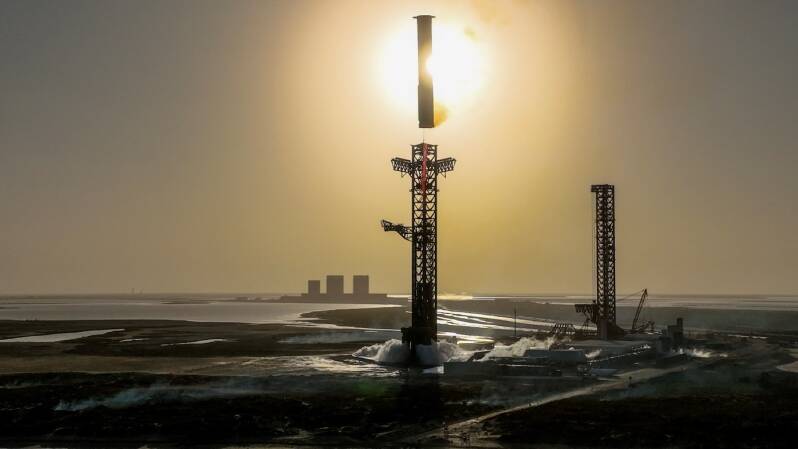Boca Chica, Texas – SpaceX launched its massive Starship rocket on its eighth integrated test flight Thursday evening, but for the second consecutive mission, the upper stage failed to reach its intended sub-orbital altitude and disintegrated in a dramatic shower of debris. A premature shutdown of multiple engines on the upper stage ultimately led to the vehicle’s loss, marking another setback for the ambitious program.

A picture perfect lift-off of Starship Credit: SpaceX
Despite the failure, SpaceX remains undeterred, viewing the mission as another learning opportunity in the iterative development of the world’s most powerful rocket.
"Obviously, a lot to go through, a lot to dig through. We’re going to go right at it," said SpaceX launch commentator Dan Huot during the live broadcast. "The primary reason we do these flight tests is to learn. We have some more to learn about this vehicle, but we’re going to be right back here in the not-too-distant future, and we’re going to get a ship to space."
Kate Tice, another commentator for SpaceX, echoed similar sentiments: "We fly to learn, and we’re learning a lot. As is the case with developmental programs such as the Starship program, progress isn’t always linear."
A Grand Liftoff but a Premature Failure
After a three-day delay due to technical issues, SpaceX ignited the Super Heavy first stage’s 33 methane-fueled Raptor engines at precisely 6:30 p.m. EST. The rocket, the tallest and most powerful ever built, ascended gracefully from the launch site at Boca Chica, Texas, creating a fiery spectacle
that thrilled onlookers gathered on South Padre Island.

Booster moments before being ‘caught’ by the mechazilla catch tower. Credit: SpaceX
Generating a staggering 16 million pounds of thrust—more than twice the power of NASA’s Saturn V moon rocket—Super Heavy carried the Starship upper stage into the sky, following an eastward trajectory over the Gulf of Mexico. As planned, the booster separated cleanly from Starship and executed a return to the launch site, where it was successfully caught by SpaceX’s massive "chopstick" arms mounted on the launch tower. This marked the third successful capture of a returning Super Heavy booster, an important milestone for SpaceX’s vision of rapid rocket reusability.
Meanwhile, the 160-foot-tall Starship upper stage continued its ascent, propelled by six Raptor engines. Everything appeared to be going smoothly until about eight minutes and 20 seconds into the flight. Suddenly, telemetry data revealed that four of the six engines had shut down unexpectedly. Moments later, onboard cameras showed the spacecraft spinning uncontrollably before communication was lost.
Spectacular video footage from multiple sources soon emerged online, showing the upper stage breaking apart in midair, with debris cascading back toward Earth. It remains unclear whether the destruction was triggered by SpaceX’s automated flight termination system or if the vehicle succumbed to extreme structural stresses during its descent.
SpaceX engineers now face the challenge of determining what went wrong. While the exact cause remains unknown, the company will conduct an extensive analysis of flight data to identify the root of the issue.
This failure comes just weeks after Starship’s previous test flight, which also ended prematurely due to a fire that developed near the base of the Super Heavy booster. That incident was traced back to a rupture in a propellant line caused by unexpected harmonic vibrations. In response, SpaceX made several design modifications, including adjusting fuel temperatures, modifying propellant feed lines, and adding additional venting and a nitrogen purge system to reduce fire risks.
Despite these changes, Thursday’s flight ended with a similar loss of vehicle control and breakup, raising concerns about underlying issues that still need to be addressed.
The Federal Aviation Administration (FAA) will likely conduct another failure investigation, potentially delaying SpaceX’s return to flight. Given the consecutive failures, regulatory scrutiny may intensify, extending the timeframe before the next test.
The success of the Starship program is crucial not only for SpaceX but also for NASA. Under a multi-billion-dollar contract, SpaceX is developing a lunar variant of Starship to serve as the human landing system for NASA’s Artemis missions. The plan involves launching a Starship lander into low-Earth orbit, where it will be refueled by multiple Starship "tanker" launches before heading to the Moon.
NASA’s Artemis program envisions sending astronauts to the lunar surface by 2027-28. However, before carrying humans, Starship must first demonstrate multiple successful uncrewed missions. The setbacks in recent test flights underscore the challenges SpaceX faces in achieving the level of reliability needed for human spaceflight.
Expanding Operations in Florida
Even as SpaceX troubleshoots Starship’s flight performance, the company is aggressively expanding its operations. SpaceX is currently constructing a massive 380-foot-tall "Gigabay" facility at the Kennedy Space Center in Florida, which will serve as a hub for processing and refurbishing Starship vehicles. The facility, expected to be completed by late 2026, will allow SpaceX to increase its launch cadence by enabling rapid turnaround between missions.
Additionally, SpaceX plans to establish a full-scale Starship production facility in Florida, complementing its existing operations in Boca Chica, Texas. Initially, completed Starships and Super Heavy boosters will be transported from Texas to Florida by barge to support early Florida-based launches.
"With production, integration, refurbishment, and launch facilities in Florida as well as Texas, we will be in a position to quickly ramp Starship’s launch rate via rapid reusability," SpaceX said in a statement earlier this week.
While Thursday’s test flight did not achieve its full objectives, SpaceX remains committed to its long-term vision of building a fully reusable spacecraft capable of reaching the Moon, Mars, and beyond. The company has proven time and again that rapid iteration and aggressive testing are central to its approach.


Add comment
Comments